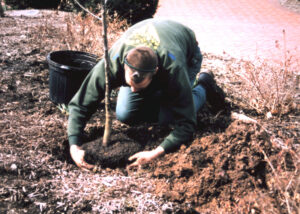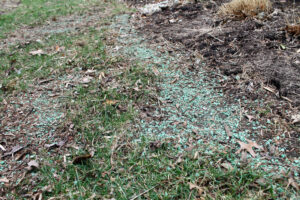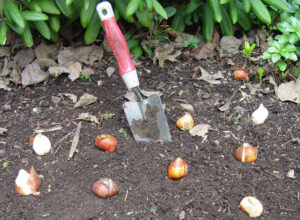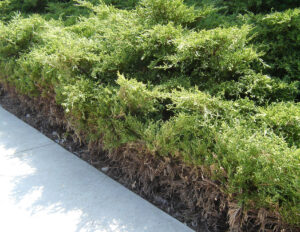Is It Too Late To…
November 14th, 2023
Most of the gardening questions I get this time of year begin with the words, “Is it too late to…” or “Can I still…”
Mid-fall is a confusing, kinda-over/kinda-not time in the garden.

November isn’t the best month to plant, but it’s not impossible either.
It’s a time when frost usually has killed the summer vegetables and annuals and slowed the growth of everything else, yet we can still string together some very nice November days in the 60s and 70s. That’s when it seems as if we could/should do something other than erect burlap barriers and go hunting for lanternfly eggs.
Here’s a rundown to help you figure out what can still go on the November honey-do list.
Q: Is it too late to plant trees and shrubs?
A: No, but your odds of success go down in November.
Cornell University did some ground-breaking experiments (har-har) on this question years ago and concluded that fall-planted plants survive best when they go in the ground at least six weeks before the soil temperature hits a root-stopping 40 degrees at the root level.
In our area, that normally translates into late October.
If the weather stays warm and damp in the coming weeks, your odds go up. If it gets very cold soon or the soil is dry when freeze time arrives, the odds go down.
I’d definitely wait until spring to plant winter-tender fare such as crape myrtle, nandina, hardy camellia, and cherry laurel. But if you get a great end-of-season bargain on a reliably cold-hardy plant, that may be worth the risk. (You probably will sacrifice any warranty, though.) Keep the soil damp until it freezes if rain isn’t doing the deed for you.
Q: How about perennial flowers?
A: Same deal. Hardy ones? Decent odds. Borderline ones? Spring is better.
We’re in USDA Winter Hardiness Zones 6B and 7A, so anything on labels rated for Zone 5 or lower is plenty cold-tough.
Watch November-planted perennials over the winter for “heaving.” Since your plants won’t be well rooted planting this late, the root balls are more susceptible to getting pushed up by freezes and thaws.
You don’t want the tops of the root balls sticking up, where cold winter wind can kill the unprotected roots.
Tamp heaved plants back down ASAP, and surround the plant with two inches of bark or wood chips if you didn’t already do that at planting.
Q: Can I still plant grass seed?
A: It’s too late for good germination now. If you’re looking to patch a few thin spots or overseed a thin lawn, your odds will be better next April.

Some grass seed can germinate during warm spells in November, but it’s generally better to wait now until spring.
On the other hand, if you have big bare spots that could erode over winter, it may be worth taking a crack at it. Keep the seeded soil damp, cover with a light layer of straw, and hope for a long, warm November.
Grass seed isn’t terribly expensive, so you’re not risking a major investment by seeding now and getting nothing. You’ll have a second shot next spring.
An alternative is laying sod (much more expensive but immediate coverage) if you can get your hands on any this late.
Q: Is it too late to plant bulbs?
A: No. You may find some excellent bargains on tulips, daffodils, hyacinths and such in the coming weeks.
These are best planted in October, but November-planted bulbs do just fine, too.

Spring bulbs can still be planted throughout November.
You’ll likely even get them to come up by planting into early December, although heights likely will be shorter and bloom time will be later. You might also have to contend with frozen soil then.
Q: Can I still trim the evergreen hedges?
A: It’s not the ideal time, but at least it’s better than early fall when plants are still in growth mode.
Pruning and shearing then is early enough that plants may push out new shoots that aren’t hardy enough to tolerate the cold when sub-freezing weather shows up soon after. They often winter-burn, making the plant look partly brown all winter and wasting growth energy that would’ve been better spent next spring.
I’d wait until at least the end of winter to prune most evergreen hedges, but you can also do the job from spring through July.

Fall-pruned evergreens are going to look chopped and bare until new growth hides the pruning next spring.
Three things I don’t like about late-fall or early-winter pruning of evergreens: 1.) The cut ends dry and brown and look bad for months; 2.) If you overdo it, the plants look chopped the rest of winter until new growth fills in come spring, and 3.) You get the size and shape just the way you want it, then snow and ice storms (or deer) come along to cause damage that forces you to cut again to reshape or recover.
Q: Can I prune flowering shrubs and trees?
A: Dormant-season pruning is OK for most leaf-dropping trees and shrubs. There are even some advantages, such as being able to see the branching better and creating less sap and leaf mess.
One possible down side is Reason No. 3 above, which is why I usually wait until the end of winter or early spring to do my dormant-season pruning.
The main argument against pruning spring-blooming trees and shrubs in the dormant season is that you’ll cut off flower buds that already have formed. That means fewer or no flowers in spring.
Flowering woody plants that bloom before June (forsythia, lilac, azalea, weigela, rhododendron, dogwood, etc.) have buds in place now and should be pruned right after they flower.
Cutting from late fall through winter won’t short-circuit the bloom of summer-flowering trees and shrubs (rose, butterfly bush, rose-of-sharon, tree-type hydrangea, crape myrtle, etc.). Those form their flower buds on wood that’ll start growing next spring.
Shade trees can be pruned anytime from leaf drop in the fall through next spring.







